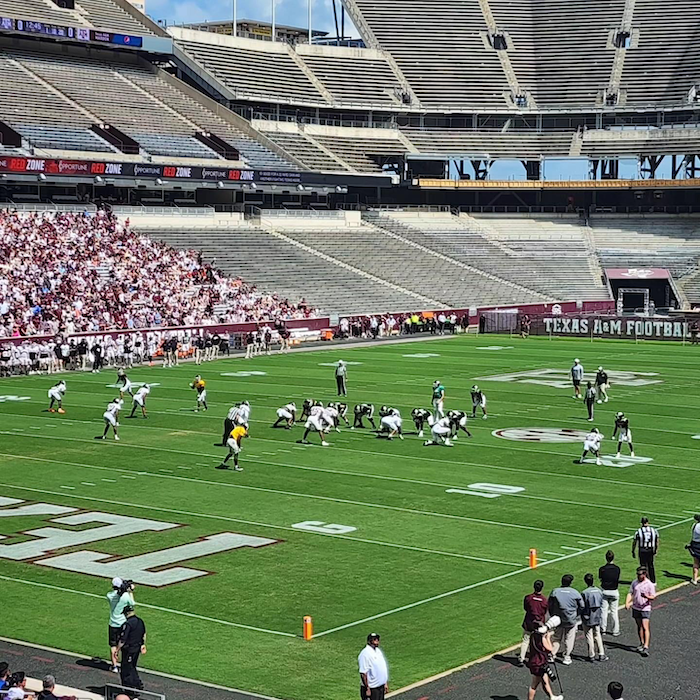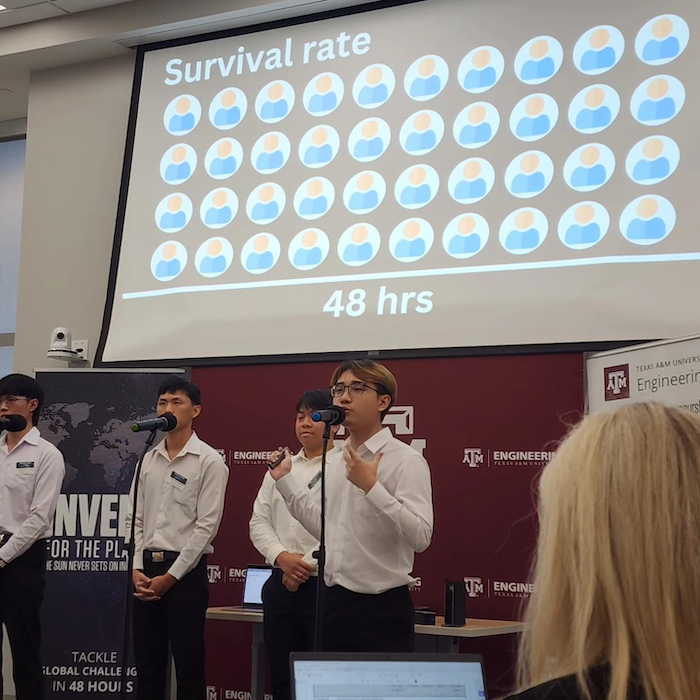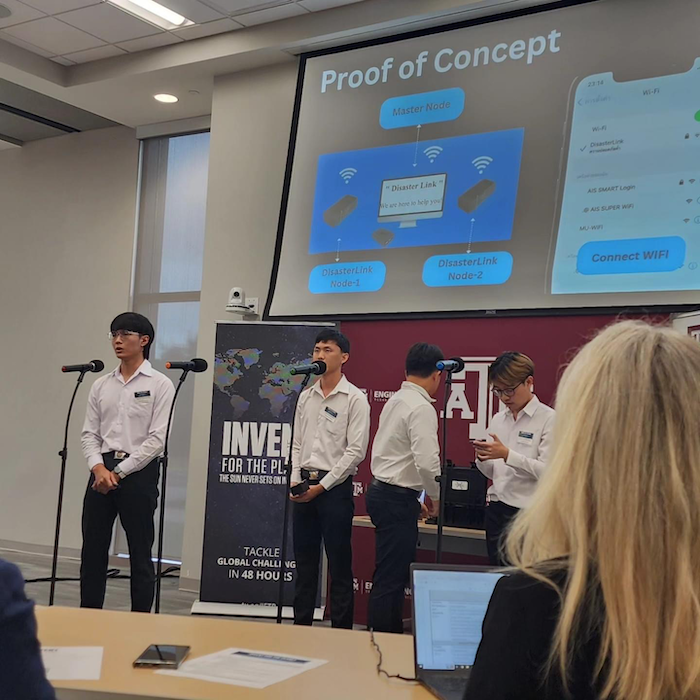eXtensions - Friday 21 April 2023
Invent for the Planet Final Presentations - Everyone's a Winner
By Graham K. Rogers

A group of Mahidol University Engineering Students took part in the final contest of Invent for the Planet this week. Although they were unplaced, they were up against a strong field. They acquitted themselves well after crossing a number of hurdles before traveling and then when they arrived in Texas. The benefits to the students and the university are immense.
A few hours ago, the finals of this year's Invent for the Planet took place at Texas A&M University, where seven teams from five countries (plus a bonus appearance of a non-competing team from Bolivia) presented their solutions to a range of problems. As I have been involved with the team from the Engineering Faculty, Mahidol University in Thailand from the first day, I do have an interest in this.
The Run up to the Event
Invent for the Planet has been running for some 5 years now and the format has been basically unchanged. Several universities round the world run concurrent events at which students are invited to examine problems: they are given needs statements. Although some groups are preformed, at the Mahidol event there is always some shuffling and students may be working with those from different departments, or even other faculties. In this way, students may be exposed to working in a team with those they may not know, and with students who have different skills sets.
Starting on a Friday evening, the groups, try to develop solutions that fit those needs statements. There is much discussion, planning on paper boards, along with gentle nudges from mentors who can advise in various ways. They are also able to chat with students at the other Invent for the Planet events using live links (including video). As well as the technical aspect, the teams must prepare for a final presentation and need to consider economic aspects of the solution, including potential backers.
By Sunday afternoon, the final day of the weekend, the students are exhausted: running on pure adrenaline as the presentations in front of a team of judges take place. Each team presents a short video to pitch the idea, then present their ideas. The winner at the Mahidol event this year was Disasterisk Spot: a combined team of Biomedical and Electrical Engineers. That was not, however, the end of things.
Before the end of the week, a video of the presentation had to be sent to the organizers. A few days later the selected teams, who would attend the final events in College Station, were announced. The Mahidol University Engineering Students were selected to Attend Invent for the Planet at Texas A&M in April.
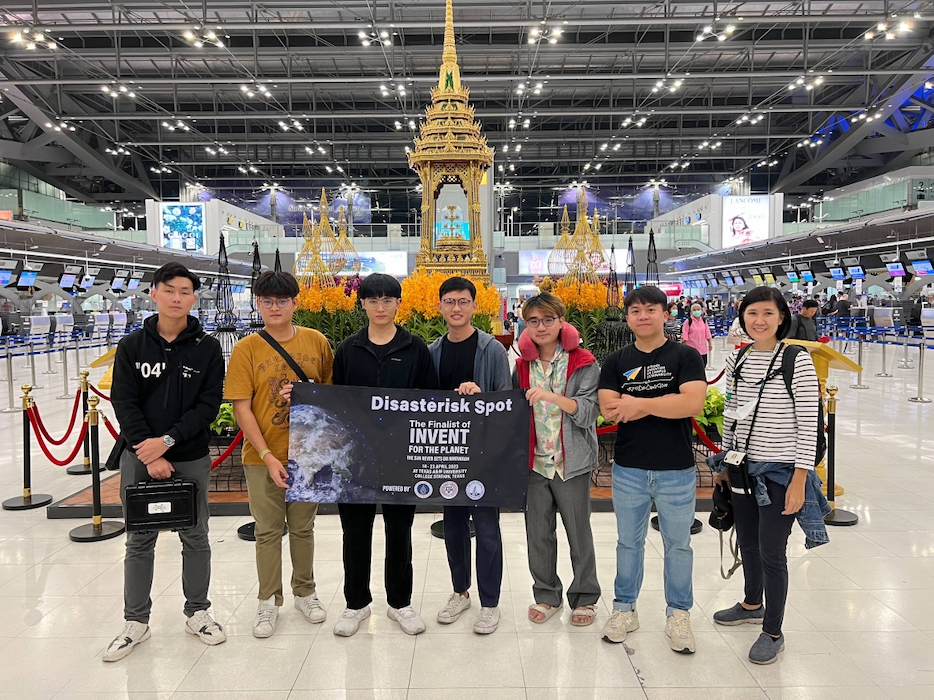
Leaving Bangkok for Invent for the Planet - Photo, Ittichote
Teachers responsible had to collect letters from the relevant university authorities, while most of the students had to apply for passports before they were able to start the visa process. After the documentation was completed, itself a fraught process for the students and supervisors, the group left Bangkok for the USA early morning on 14 April.
Looking around Texas A&M - photos, Somnida
The Main Event
Having arrived at Texas A&M the students were thrown into a round of meetings, social events, dinners and a football game (a totally new experience), while in the background final preparations for the contest continued. This involved fine-tuning the technology and the presentation.

Fine-tuning the presentation - source unknown
While this was going on, two of the students were taken ill and had to isolate. They would not be talking part in the event, but once they felt better they did work on the equipment. With a reduced presentation team, adjustments were needed and the slides were checked in a Webex meeting, although some late changes were made as they rehearsed.
The order of presentations was published, placing the Mahidol team third. Each team had 10 minutes to make their presentation, followed by a 5-minute Q&A session. The group from Texas A&M, New Mexico, who had tackled the same needs statement as the Mahidol students, but with a different solution, went first. I was able to follow the event via a live YouTube feed. I took notes and some screenshots.
- TF 575 by the New Mexico student group started off a little shaky, but set out the scope of the project clearly. The concept was to use pre-deployed balloons to float 4G nodes over a disaster area, such as post-Hurricane Katrina. Several nodes used together create a mesh network, restoring communications. The ideas were set out well, but they seemed to stumble over a question from a British lady judge.
- The Izzy Filter from Texas A&M, Corpus Christi students was a People's Choice: chosen by attendees at a poster session the day before. As this was less than 24 hours before the presentation, a couple of members were absent, but the remaining pair acquitted themselves well. The project was a way to produce safe water in remote areas, using locally-sourced materials for filter chemicals. They would be able to tailor the equipment to deal with problems specific to the area, such as high metal content in ground water. The geo-specific and modular design had several good points and showed the team's interests in the technology and the problems.
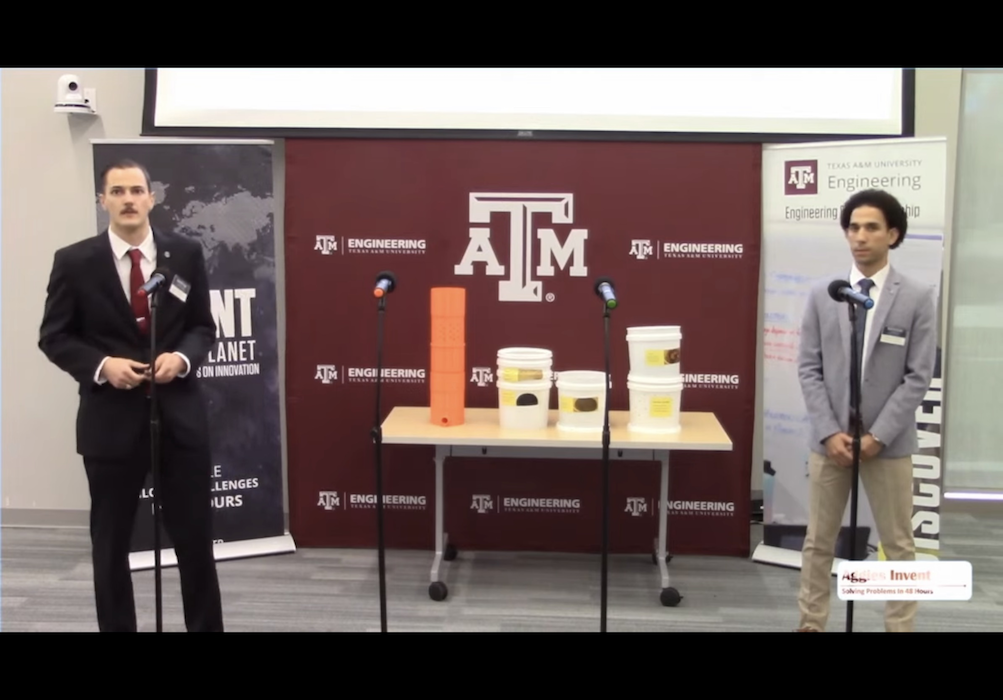
Izzy Filter - screenshot
- The Mahidol team with their Disasterisk Spot communications solution were slightly hesitant at the outset: nerves perhaps. This was not helped when there was a problem with the university equipment. There was a time out and the screens went blank. When they returned, the team carried on with no hesitation and set out their solution, using the example of the earthquake in Turkey earlier this year rather than Hurricane Katrina, as this had happened a few days before the February event and was a fresh example of just how bad a disaster could be. They had two types of node to produce a mesh network and while they had earlier referred to this as master and slave units, advice given suggested this may be less widely acceptable. They changed the wording to "Prime" and "Secondary". After the presentation, they covered the questions fairly well.
Mahidol team - photos, Somnida
- H2 Grow was presented by the team from Swansea University. Initially it seemed similar to the Izzy Filter in intent, but this was not to provide drinking water. The device was to help agricultural communities, particularly in SE Asia where water is sometimes polluted with heavy metals and unsuitable for growing crops. The water was pumped using a pedal system, like a bicycle but made from plastic. Each unit had a plug-in filtering system based on reverse osmosis.
- A team from Habib University in Pakistan presented a solution they called FinDiesel that would help convert discarded fish products like scales, fins or bycatch - otherwise thrown back into the sea - into biodiesel. The process which could be done by family members in the home, converted the waste into oils that could then be reprocessed into a low quality biodiesel: what would otherwise be waste, helping to reduce costs. Under questioning, it was clear they had done their homework and understood not only the socio-economic impacts, but also how the chemistry worked.
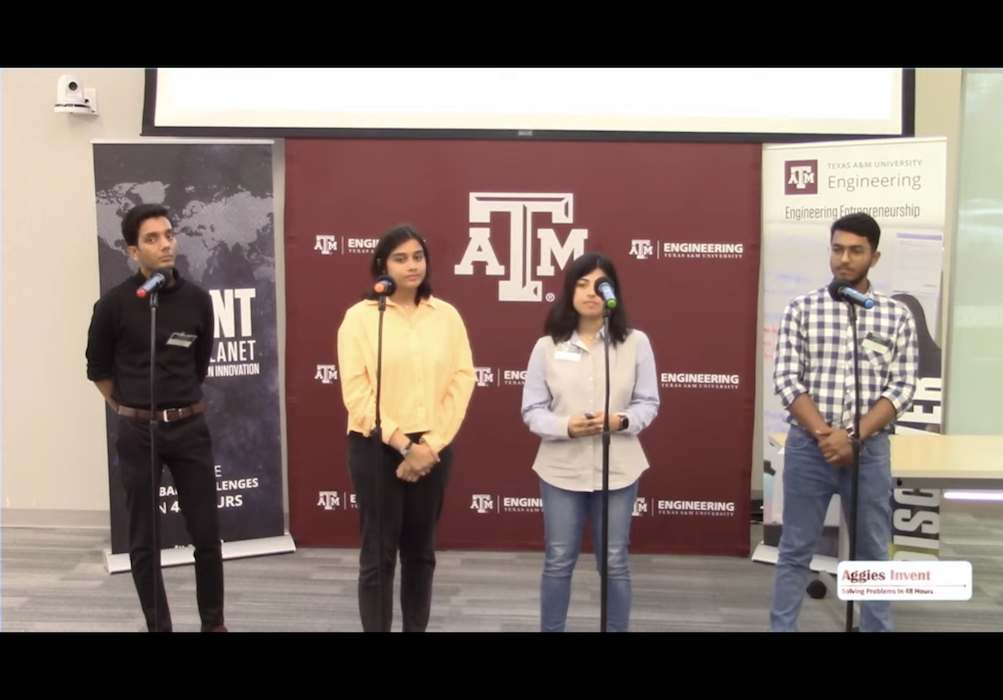
Fin Diesel - screenshot
- While other presentations that considered disasters looked at restoring communications, the group from Texas A&M examined the problems of temporary housing: immediate, short term and long term. They suggested a modular housing system that could be easily assembled (and disassembled for use elsewhere). They discussed various materials and noted that a steel I-beam was not too heavy for a couple of people to carry. During questions they were asked if they had considered building a full size unit rather than the small-scale prototypes.

Displace, temporary housing solution - screenshot
- The final team in the contest to present was from Texas A&M in Qatar: Eco Energizers. They looked at problems with the deployment of solar panels which suffer from micro-cracks and dirt, which reduce the efficiency over the life of each panel. Several groups of students at the Faculty of Engineering are looking at ways to up the efficiency, but this solution was radical and used new materials with a smaller unit sizes and shape. They claim that although slightly more expensive than the current panels, the product life of 50 years as opposed to 25 years makes up for this.
Before judging took place a small group from Bolivia who had attended the event as observers - hopefully they will compete next year - was given a few minutes to outline problems in their region: the Amazon Basin. As well as this being an important area for ecology, it is under attack from those stripping the forest, with additional problems from fires. As we are aware here, such fires add considerably to pollution and create health problems for many. With regard to the fires, the speakers commented on the importance of prevention, detection and mitigation.
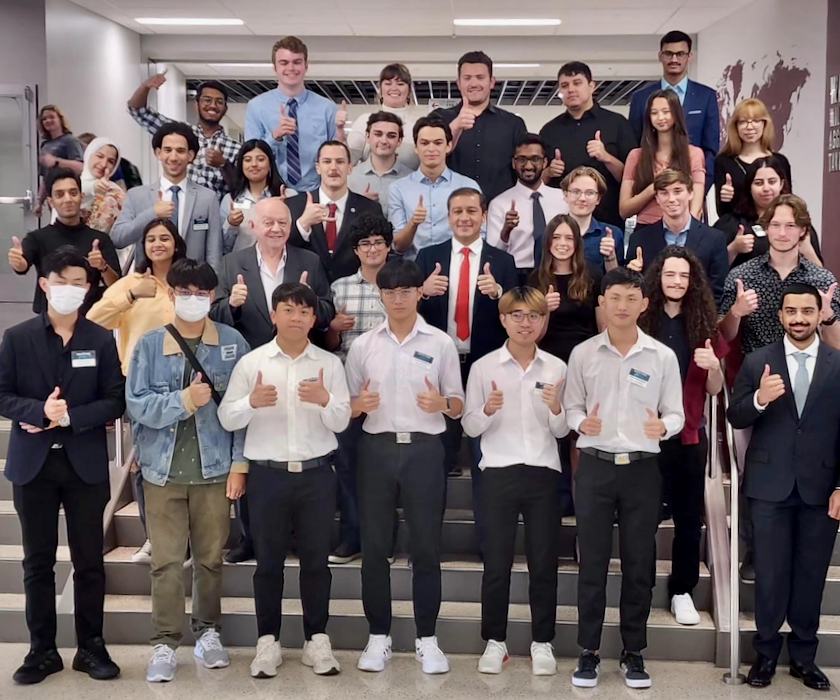
Invent for the Planet: Competing Teams + Bolivia - source: Somnida
At 00:08 (Thai time) the teams left the room for a photograph session while the judges discussed the various solutions and the live stream was put on hold. At 00:26 the transmission resumed and the results were announced in reverse order:
- Third place with a prize of $2000 went to the Eco Energizer solution from Texas A&M in Qatar;
- The second place prize (with $3000) was awarded to the group from Habib University in Pakistan with the FinDiesel project; and
- First prize, with a check for $5000 went to the team from Swansea in Wales for the H2 Grow solution.
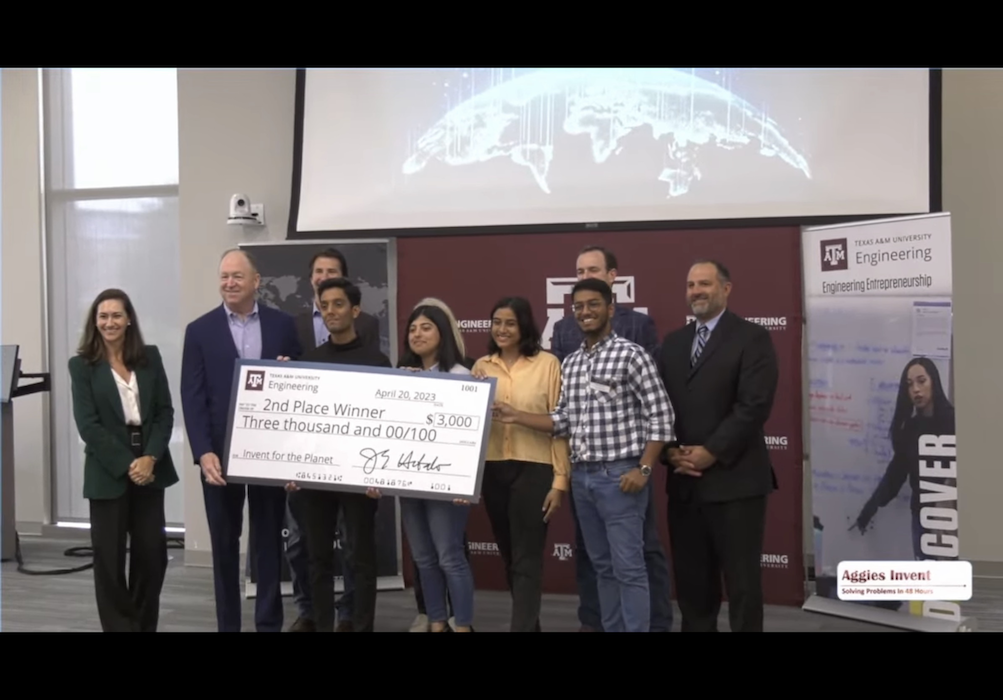
2nd Prize and the check to Habib University, Pakistan - screenshot
While there was a certain sadness that the teams from Mahidol University had not been successful, this was a job well done in a strong field. Much was gained by competing; and much was learned. One of the students mentioned that he really appreciated all the experience he had gleaned. He said that he had done his best and had no regrets. This is similar to other comments I had heard from students at the local event: tired, but learned so much.
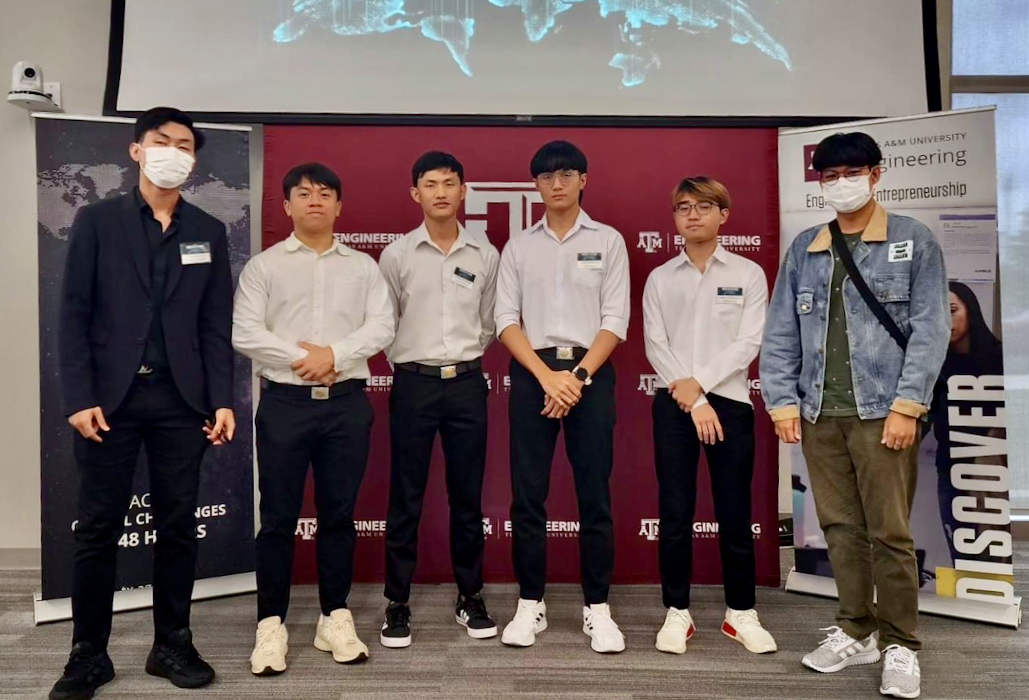
Invent for the Planet: Mahidol Engineering Team - source: Somnida
Taking part in an event like this gives students, some of whom have never been out of the country before, a valuable experience. They meet new people, they learn about different cultures, meet new friends. The whole experience is a plus - even applying for the visas is a lesson. The travel, the teamwork, the product development, meeting all those new people, facing experienced judges with their questions, all give them positive experiences.
Plus a couple of unusual lines on the résumé.
Graham K. Rogers teaches at the Faculty of Engineering, Mahidol University in Thailand. He wrote in the Bangkok Post, Database supplement on IT subjects. For the last seven years of Database he wrote a column on Apple and Macs. After 3 years writing a column in the Life supplement, he is now no longer associated with the Bangkok Post. He can be followed on Twitter (@extensions_th)

For further information, e-mail to
Back to
eXtensions
Back to
Home Page
All content copyright © G. K. Rogers 2023
![]()


